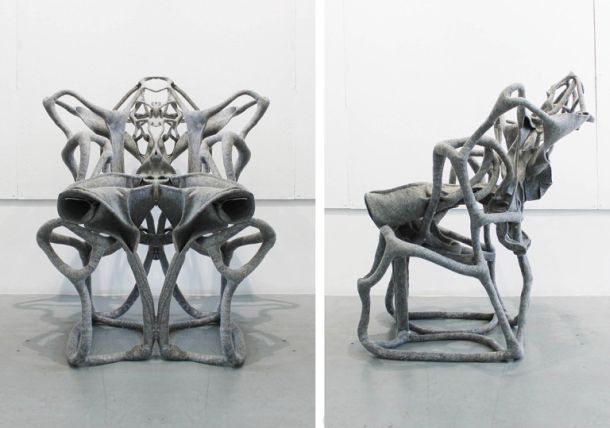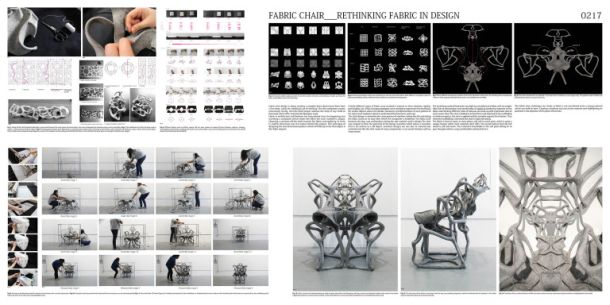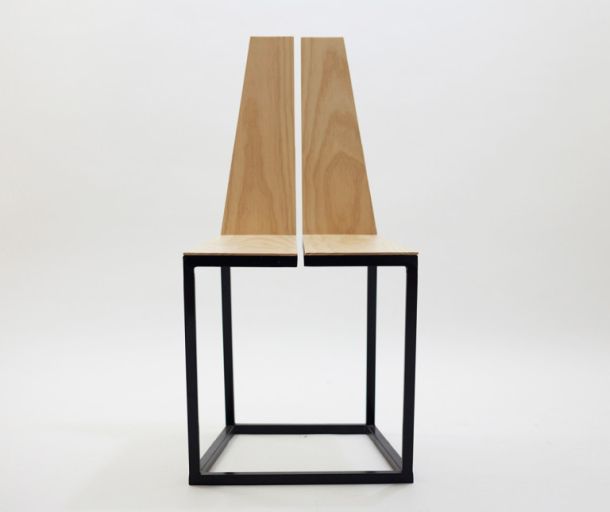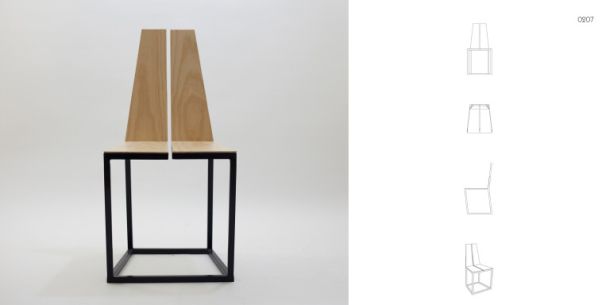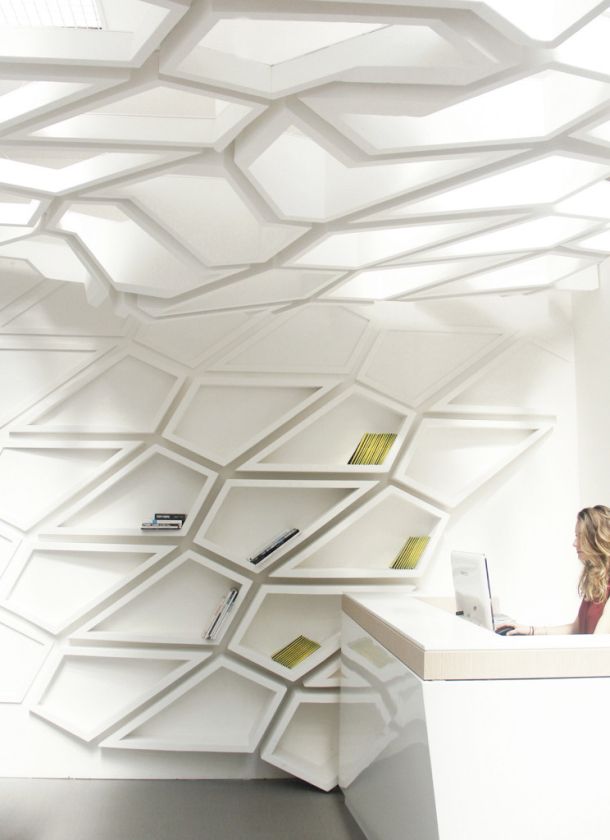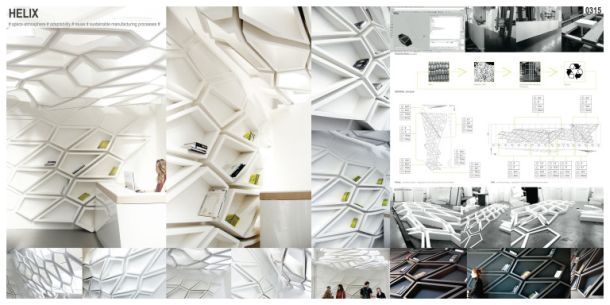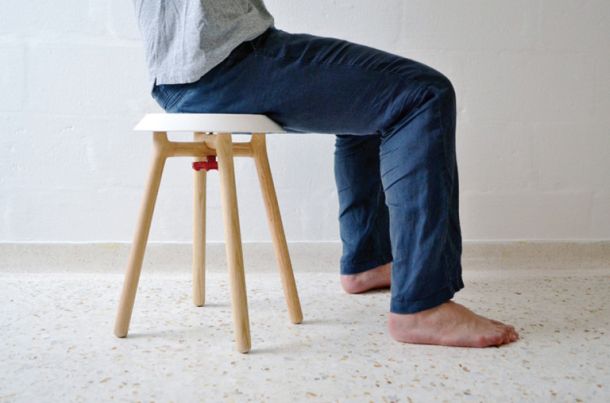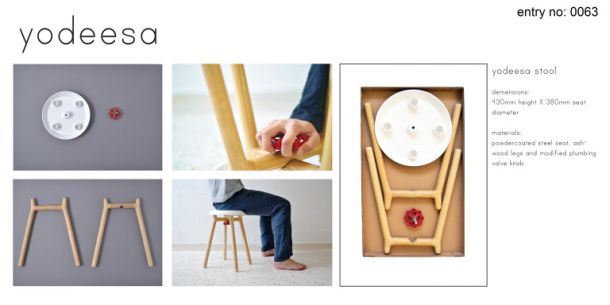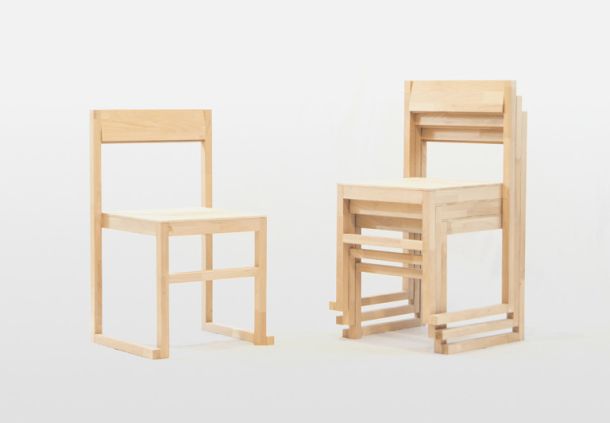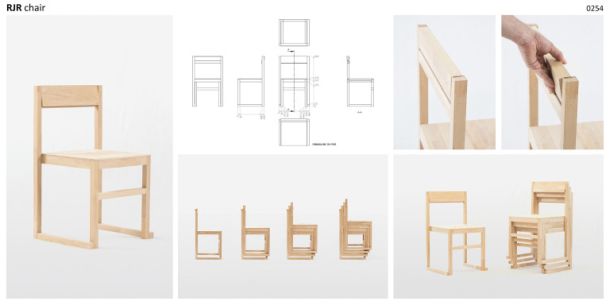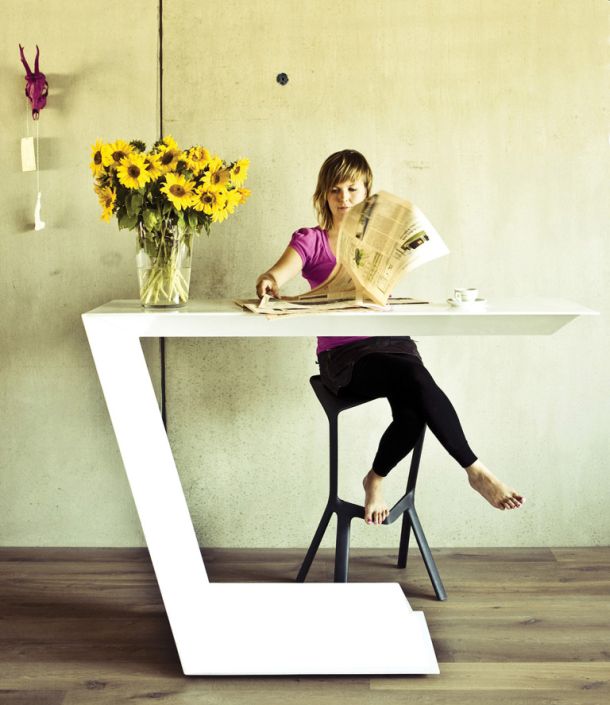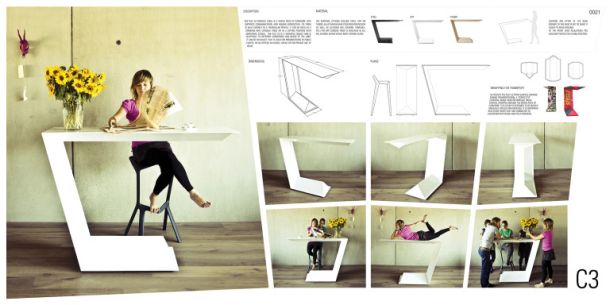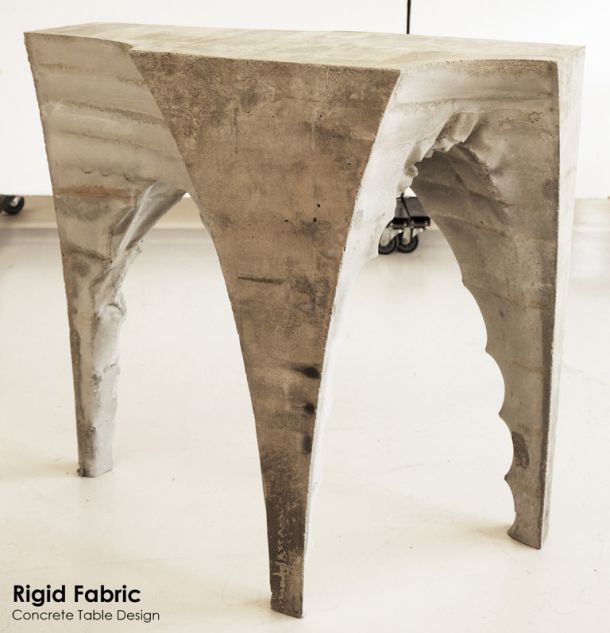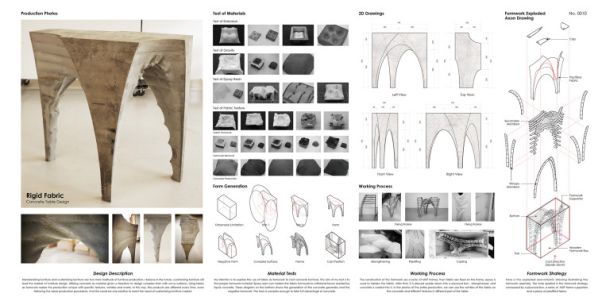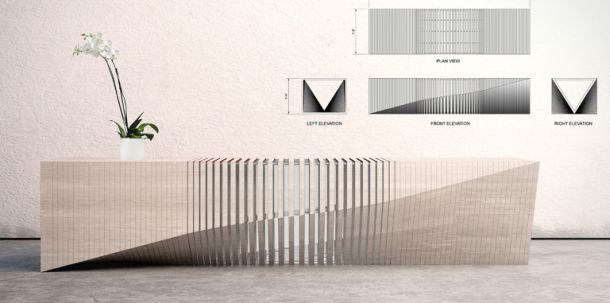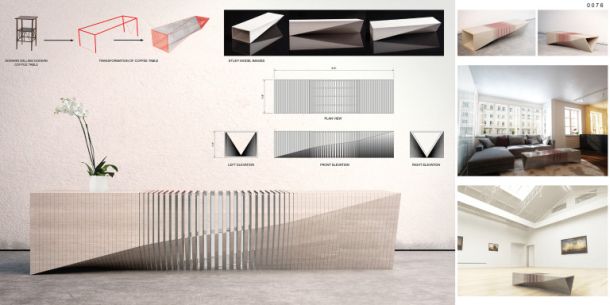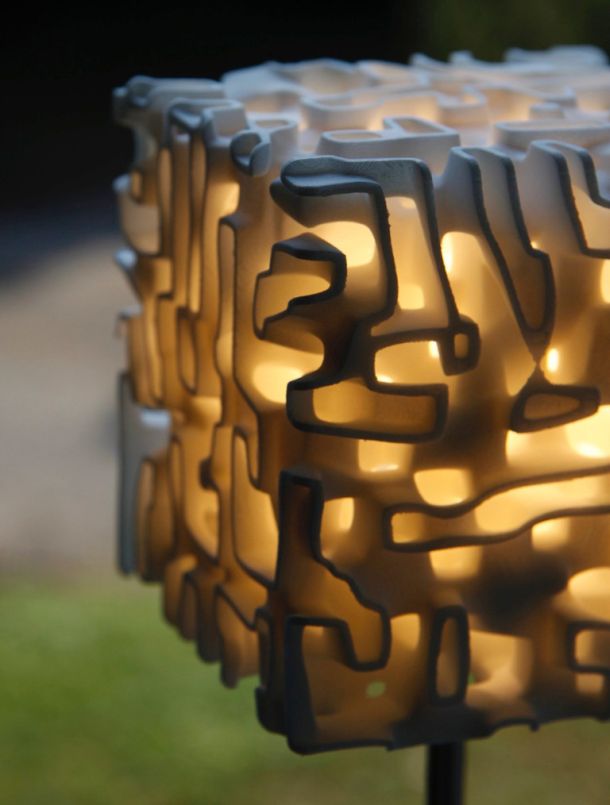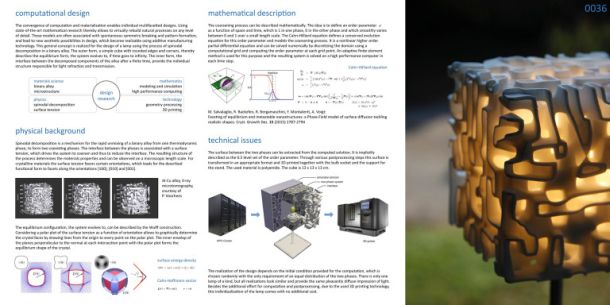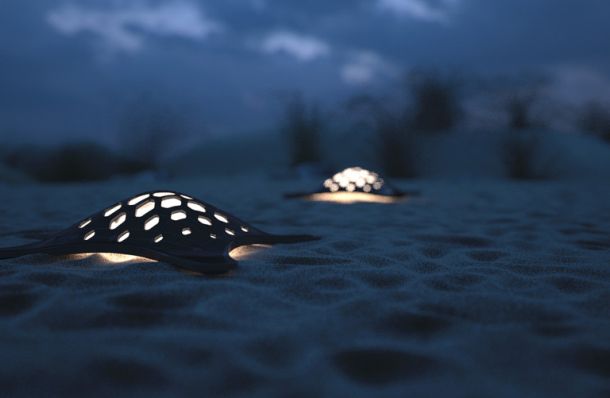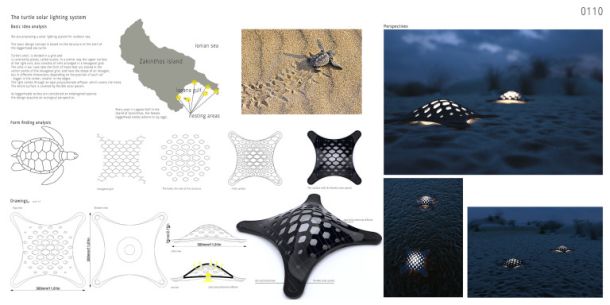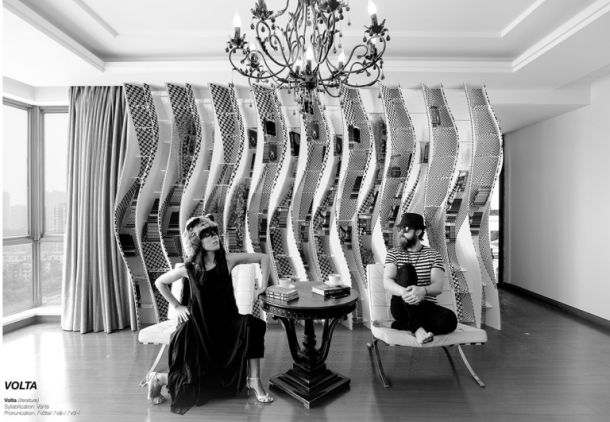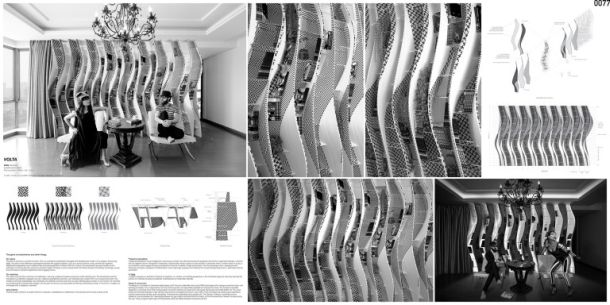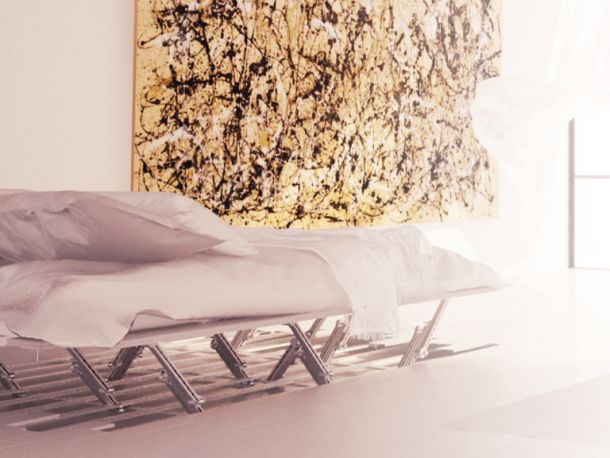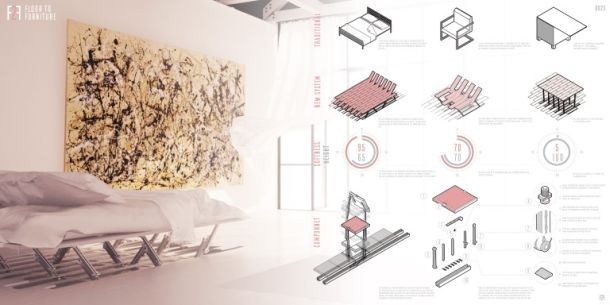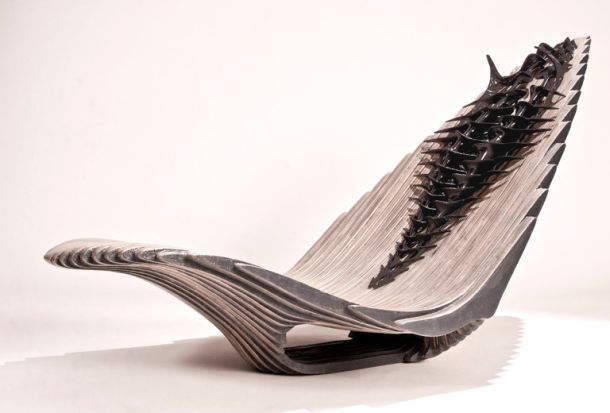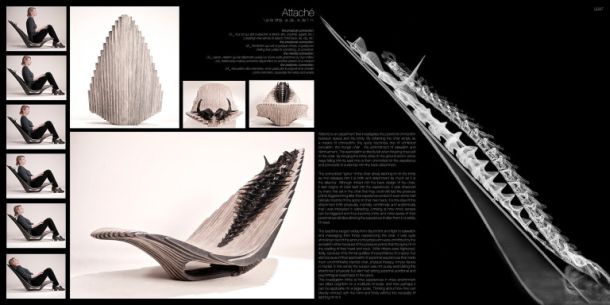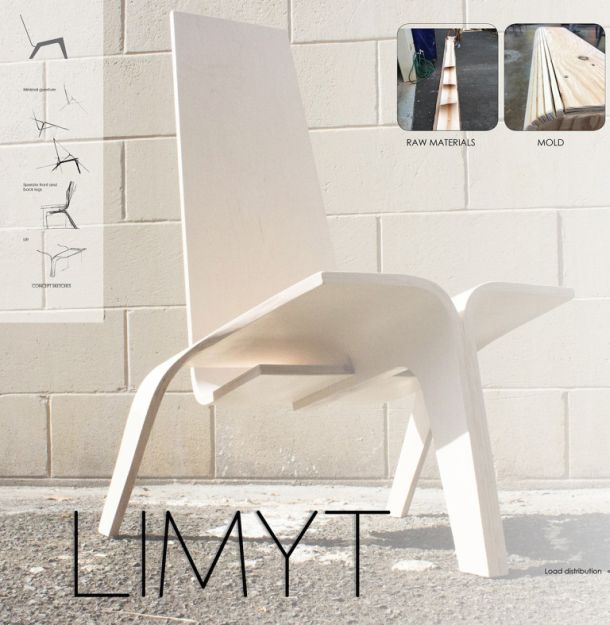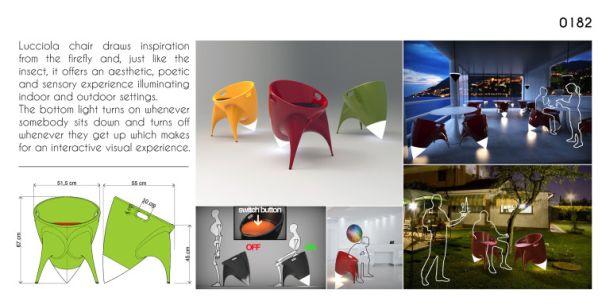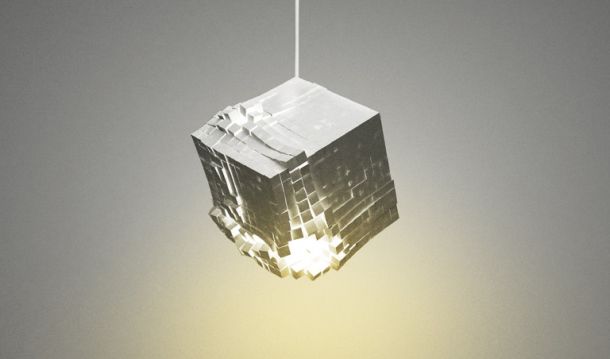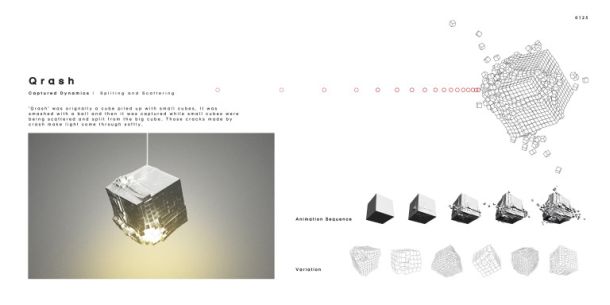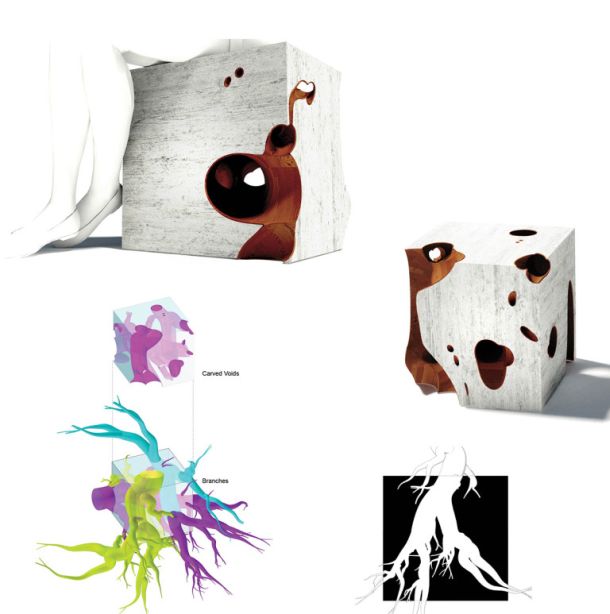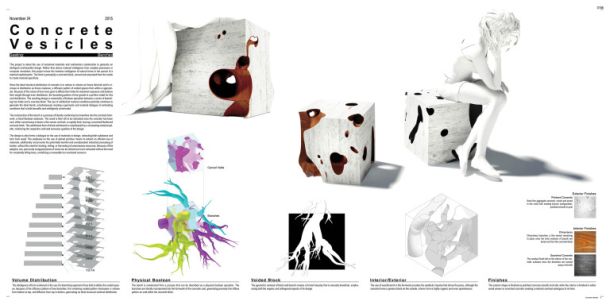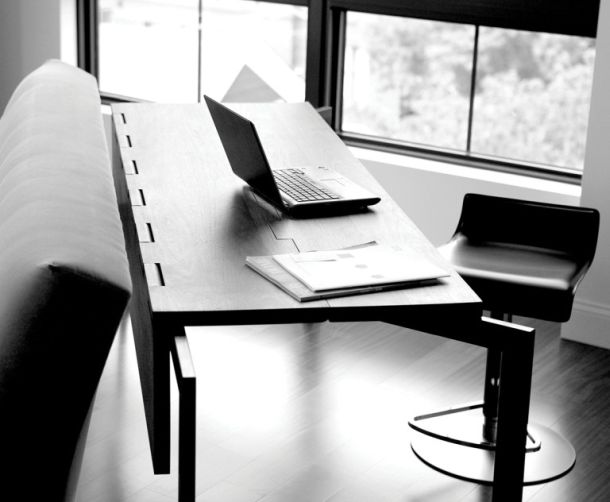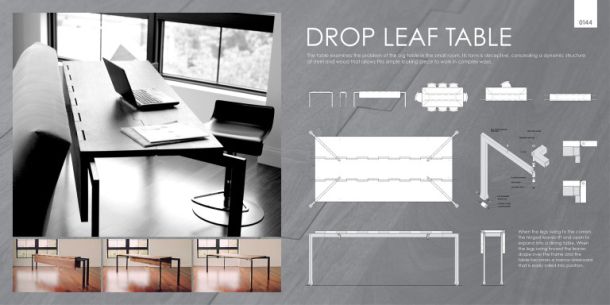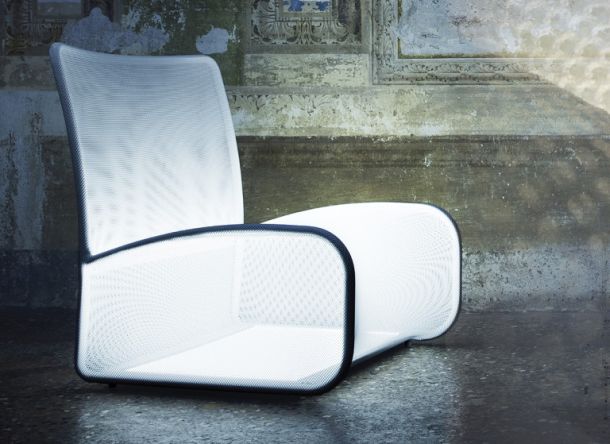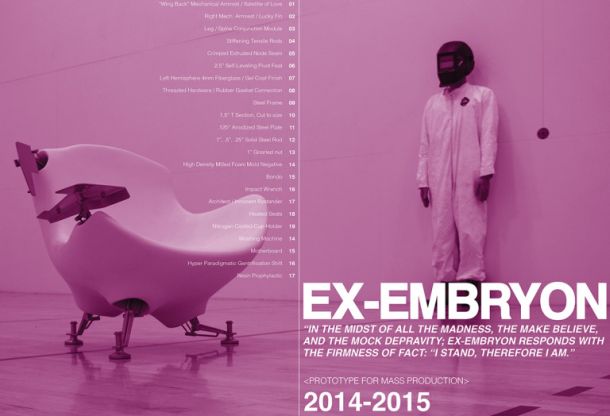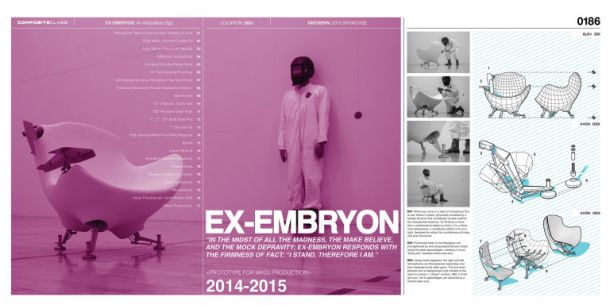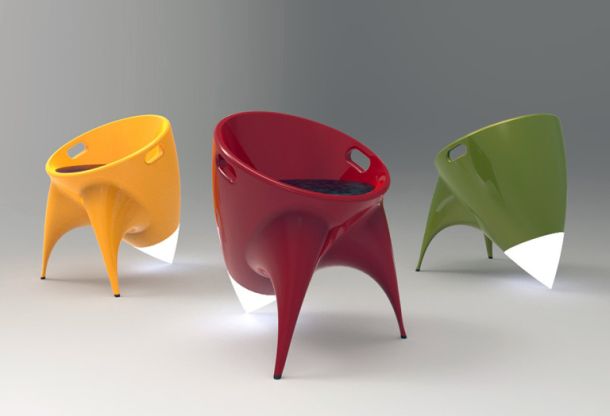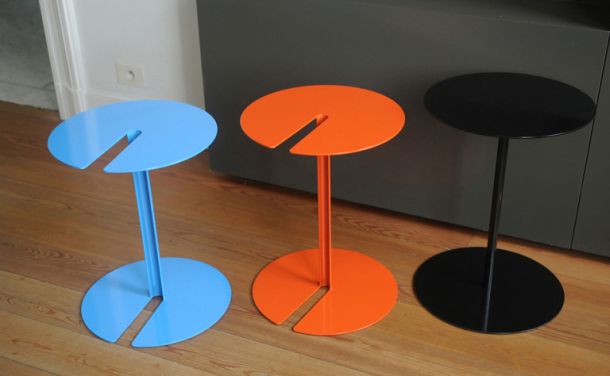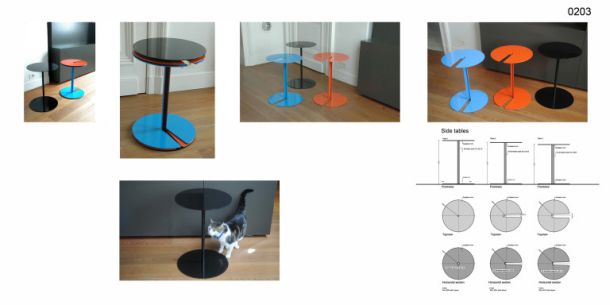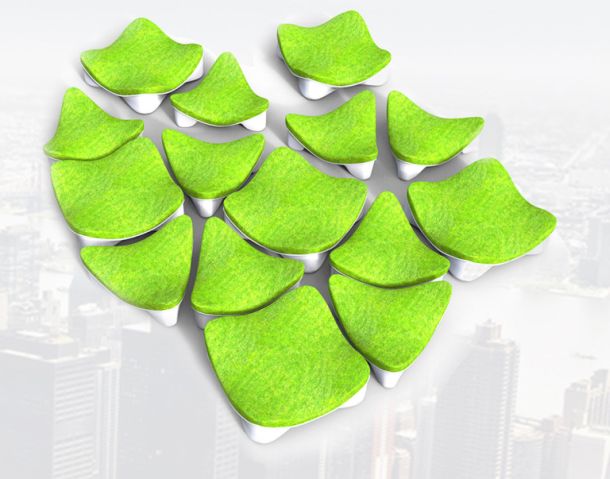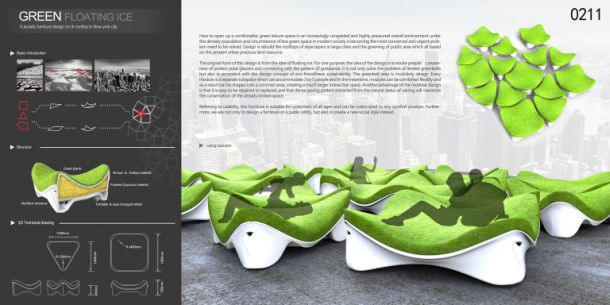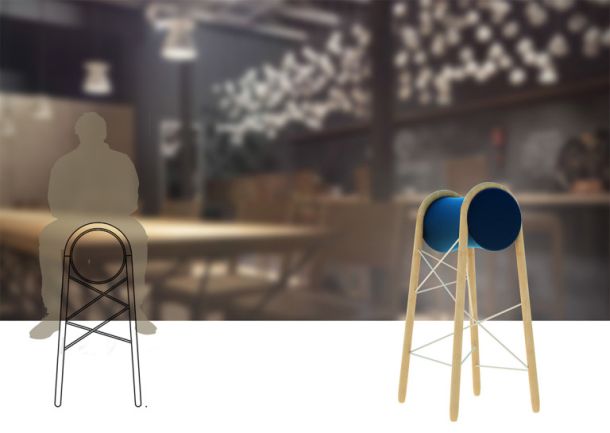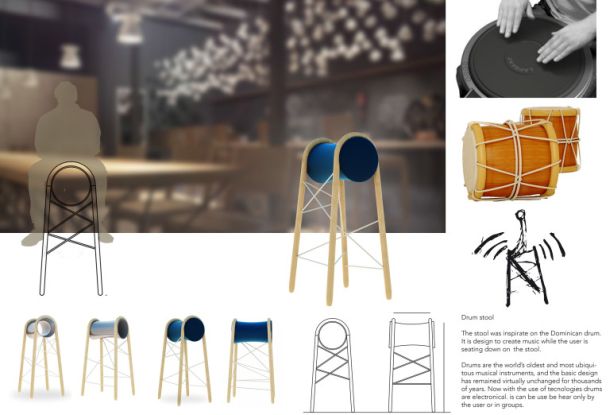Pouco antes do natal de 2015 a eVolo Magazine, tradicional publicação de arquitetura e design, divulgou os ganhadores e as menções honrosas do “2015 Furniture Design Competition”, anunciado aqui também em 18 de Agosto de 2015. Abaixo os detalhes dos ganhadores e seus curiosos projetos:
eVolo Magazine is pleased to announce the winners of the 2015 VMODERN Furniture Design Competition. The award recognizes innovative design and creates a forum for the discussion and development of the discipline. What is the future of furniture design?
eVolo Magazine received 233 entries from 34 different countries. The Jury selected 3 winners and 20 honorable mentions.
The first place was awarded to I-Ting Tsai, Xixi Zheng, Yiru Yun, and Somdatta Majumdar from the United Kingdom for the design of Fabric Chair. This project is an investigation on the use of fabric as a structural material in furniture design. A special resin was developed to harden fabric placed on a rigid mold. The resin hardens the fabric to become structural while retaining its softness in specific locations.
Studio La Cube from Spain received the second place for their project Simmis Chair. This simple and elegant design is a study on symmetry and proportions. The goal was to create a dialogue between visual lightness and the strength and heaviness of wood and steel.
The third place was awarded to Open Source Workshop from Italy and the United States for the design of Helix, a diffuse furniture system that generates a continuous interior space by adapting simultaneously to any vertical and horizontal surface while defining an immersive spatial atmosphere.
The honorable mentions include materials explorations, the use of digital design and manufacturing processes as well as studies in ergonomics and experiential possibilities.
The members of the Jury are: Ammar Eloueini [principal Ammar Eloueini Digit-all Studio], Joel Escalona [principal Joel Escalona Studio, NONO], Mitchell Joachim [principal Terraform ONE], Po Shun Leong [principal Po Shun Leong Design], and Alexander Lervik [principal Lervik Design AB].
Fabric Chair
First Place
2015 VMODERN Furniture Design Competition
I-Ting Tsai, Xixi Zheng, Yiru Yun, and Somdatta Majumdar
Daniel Widrig, Soomeen Hahm and Stefan Bassing (tutors, Bartlett School of Architecture, UK)
United Kingdom
Fabric chair design is about creating a complex three-dimensional form from a flat sheet, using the traditional art of stitching. This felt composite creates structurally strong, intricate fluid shapes without the help of any mold or formwork which other materials like fiberglass would need.
Fabric in architecture and furniture has long existed but the invention of a composite that makes the fabric the main structural material is unique. Choosing a common off-the-shelf material like fabric and exploring its limits in another dimension was the motive behind this project. This technique of designing the two dimensional pattern which will fold up to the final object is like ‘fabric origami’.
Initially, different types of fabric were studied taking in consideration their elasticity, rigidity, permeability, etc. Initial concept prototypes were created to experiment this technique for smaller objects where double curvatures and the deformations of each pattern of the sheet were studied in detail to understand the forces behind the final forms achieved.
The same process of a machine cutting the felt and letting the fabric stand on its own while the composite is hardened created the chair design. The fabric itself becomes the legs, seat and backrest. The chair was created to show the potential of this design invention, which allows the transition from a 2D surface to a 3D object. Seamless designs are rare due to material size restriction but like the chair made of many components, it can create furniture with no visual seams.
The hardening material had to be very light to not deform the fabric with its weight. After lots of permutations and combinations of applying hardening materials to the fabric and checking different ratios of mixtures we came up with a particular ratio of some special resins. Once the chair is folded to its final form and attached to the scaffolding at minimum places, the resin is applied and the complex organic form freezes. Thus when the scaffolding is removed, the chair is rigid and strong.
The fabric is hard as stone in some places and soft in some parts, which is quite a unique feature, which most materials don’t offer. The overall texture still feels like felt, which is soft and warm. The material is breathable in the soft parts letting air to pass through and has a cozy comfortable cushion feel to it.
The Fabric chair challenges our minds, as fabric is not considered to be a strong material able to hold its own form.
Simmis Chair
Second Place
2015 VMODERN Furniture Design Competition
Studio La Cube
Spain
The Simmis Chair plays with its symmetry from different perspectives. There is symmetry between the wood parts, highlighted by a central incision, which is the key element of the chair’s aesthetics. This incision provides lightness, balance, and visual delicacy, which are counteracted by the strength of the material and the cubic form of the lower part. There is also a second symmetry which corresponds to the inclination of the lower cube and the back of the chair – the profiles of these two elements make a symmetric figure between the higher and the lower parts.
Helix
Third Place
2015 VMODERN Furniture Design Competition
Open Source Workshop. Marcella Del Signore, Giuseppe Morando, Elena Del Signore
Italy, United States
Helix is a diffuse furniture system that generates a continuous interior space by adapting simultaneously to any vertical and horizontal surface while defining an immersive spatial atmosphere. Its form recalls a natural system that emerges from the structure beneath.
Helix is modular and can be aggregated in different forms following the logic of spatial branching and growth. The spatial pattern is generated through the repetition of vertical zones (A and B) of the same base module that generates the 3D macro-aggregate surface cut through planes that emphasize the perspectival views of the sequence from the corridor to the interior space. The system morphs the space allowing the viewer to follow the visual continuous trajectory generated by the wrapper (wall + ceiling). The aggregate surface adapts in response to the specific site conditions and programmatic requirements with each module shaped by scripted rules.
It is manufactured through iterative procedures guided by a 5-Axis CNC wire able to carve out the modules from a solid mass of material. Helix is made of EPS- expanded polystyrene obtained by corn; it is completely recyclable and the manufacturing process helps to reduce CO2 emissions allowing the project to be completely executed through fully sustainable processes. The structure is lightweight yet highly resistant due to the resin finish.
Helix investigates the notion of space-atmosphere, adaptability, reuse, and sustainable manufacturing processes.
Yodeesa Stool
Honorable Mention
2015 VMODERN Furniture Design Competition
Ivan Ho
Singapore
Yodeesa is a stool conceived around aesthetic and construction simplicity. The stool is made up of 3 major components, the seat (steel), the legs (ashwood) and the securing knob (modified plumbing valve knob). No tools or hardware is required to assemble/disassemble the stool.
Triggered by the study of a domestic stool, yodeesa’s objective is to break the stool down into its basic form/structure and to explore and understand the union of materials and simplifying assembly techniques. These explorations in turn lead to a series of ergonomic studies on the various tactile qualities of the stool. The flanged seat, thickness of legs, the plumbing valve knob, wow can all these elements enhance the user experience?
By applying these findings on materiality, construction and assembly. The stool can be easily taken apart and locked in place where the center intersection is located with a securing knob by hand within seconds. The stool can also be flat packed into a 680x400x50mm package.
Yodeesa Stool Folder (ampliar)
RJR Chair
Honorable Mention
2015 VMODERN Furniture Design Competition
Mario Alessiani
Italy
RJR is a wooden stackable chair designed for the Italian brand Slow/d.
Company
This company is particular because it has no factory but a network of craftsmen all around Italy who collaborate with it. Slow/d has a regular catalogue; the customer goes in their online shop and buys a product. The craftsmen closer to the place you want the object to be sent manufacture the design piece (just after it is bought, there is no warehouse). In this way everyone works and we have less transportation and pollution .
Chair
The aim of the designer was to make a wooden chair that can be build by the most number of carpenters in order to make the net of artisans capable of doing it as big as possible. The idea was to create a design that could be done with base carpentry tools but with something more that makes the chair recognizable and functional.
In terms of structure and composition the chair is very easy to do thanks to the straight lines of the design, but the design has something more, something that makes it interesting. The chair has a system that makes the backrest twist in order to make it more comfortable and also a little funny. It can also be stacked creating an interesting pattern that makes it visually interesting when not in use.
Conclusion
This is not the design of a chair; it is a way to do design, from the sketch to the actual object. A design that does not think just at shape, materials or marketing, it is a design that thinks about the entire process and wants to change how things are and give an alternative to mass production. In this way people can buy from local artisans – it is a new design formula.
Pult c3 Table
Honorable Mention
2015 VMODERN Furniture Design Competition
Studio WG3 ZT KG
Austria
The Pult c3 Table is a simple piece of furniture that supports communication and human interaction. Its form is built entirely in a triangular profile. It can be used as a standing bar, console table or in a sitting position with additional stools. The Pult c3 is a versatile object and is adaptable to different conditions and needs. It can be an object that is used for presentations at public events, in offices in huddle areas or for private use at home.
The material options include steel, grp or timber, all of which make it suitable for indoor as well as outdoor use (garden, terraces, etc.) The grp console table is available in all ral shades, either in silk matt or high gloss.
Pult c3 Table Folder (ampliar)
Rigid Fabric
Honorable Mention
2015 VMODERN Furniture Design Competition
Tian Yi
Hong Kong
We believe that in recent years the furniture market has changed from standardization to customization. People prefer to purchase unique furniture. The main problems are the cost and the craft. We think that the use of concrete could be a solution by reducing the cost and technical difficulty.
Concrete is widely available and easy to work with. If we use concrete to cast in place, it may not need different members and joints to link the whole furniture. Concrete furniture can be casted once efficiently. Also, utilizing concrete as material gives us freedom to design complex form, which could be a design trend in future of furniture design.
Fabric as formwork can be extended, twisted and curved in almost any imaginable form, it also makes the product unique with specific textures, wrinkles and marks. In this way, the products are different every time, even following the same production procedure.
The intention of this project is to explore the use of fabric as formwork to cast concrete furniture. The aim of material test is to find a proper formwork fabric. Epoxy resin can harden the fabric formwork to withstand forces exerted by liquid concrete, which gives freedom to the shape of furniture.
The construction of the formwork frames use a series of MDF frames, then fabric is fixed on the frame, epoxy resin is used to harden the fabric, after that, it is placed upside down into a plywood box, strengthened, and concrete is casted into it.
Turntable Coffee Table
Honorable Mention
2015 VMODERN Furniture Design Competition
Steven Haardt, Roy Oei
United States, Hong Kong
The Turntable Coffee Table design is conceived as a re-interpretation of what is considered the first coffee table designed by Edward William Godwin. By maintaining the main functional concept; i.e., a utilitarian tabletop, the Turntable transforms the practical components into something iconic. By altering the positioning of the legs inward on one side forming a triangle and fusing them together on the opposite side creating a rectangle an asymmetrical relationship of the structural elements is produced. The journey between these two opposing geometries is shaped by a series of unique ribs. When these individual parts are laminated together, they form a self-supporting structural shell. The lamination of the ribs begins to pull apart at the center revealing the assembly of the table to the user. Transitioning from a rectangular to a triangular shape not only recreates some of the geometries in the Godwin table but also carves a space for a person’s legs and feet to comfortably rest while sitting adjacent to the table. The hollow inner volume sculpted as a result of this evolution allows for the storage of books and magazines within this void.
The seamless form was achieved using Rhino modeling software. A series of modified rectangular and triangular geometries were explored in the computer and in a variety of physical paper models in order to achieve a self-standing table. A final scaled massing prototype was 3D printed out of plaster with the addition of a liquid hardener applied during the curing process. The coffee table is strong enough to sit on and its weight distribution is balanced making it resistant to tipping.
The full-scale coffee table is constructed of a series of half inch laminated Baltic Birch wood ribs cut on a CNC 3D router. Each rib is composed on a plywood sheet in a specific manner to maximize the amount cut at once while reducing the amount of waste per plywood sheet. The Baltic birch material is comprised of an attractive vertical grain that runs lengthwise throughout the sheet. The inner plies have alternating horizontal or vertical grain, which provides increased strength and resistance to warping or moisture damage while adding texture to the surfaces of the table. Another reason for using Baltic birch is its uniform grain, which gives it a natural finish with little sanding and staining. Acrylic inserts of various thicknesses are inserted in between the plywood laminations and are held in place by a series of stainless steel rods. These rods also assist in connecting the wood laminations.
The Turntable is a contemporary conversion of a traditional coffee table. It is distinctive enough to be used as a centerpiece and functional enough for everyday use.
Turntable Coffee Table Folder (ampliar)
Spinodal Table Lamp
Honorable Mention
2015 VMODERN Furniture Design Competition
Axel Voigt
Germany
Computational design
The convergence of computation and materialization enables individual multi-facetted designs. Using state-of-the-art mathematical research thereby allows to virtually rebuilding natural processes on any level of detail. These models are often associated with spontaneous symmetry breaking and pattern formation, and lead to new aesthetic possibilities in design, which become realizable using additive manufacturing technology. This general concept is realized for the design of a table lamp using the process of spinodal decomposition in a binary alloy. The outer form, a simple cube with rounded edges and corners, thereby describes the equilibrium form the system evolves to, if time goes to infinity. The inner form, the interface between the decomposed components of the alloy after a finite time, provides the individual structure responsible for light refraction and transmission.
Physics background
Spinodal decomposition is a mechanism for the rapid un-mixing of a binary alloy from one thermodynamic phase, to form two coexisting phases. The interface between the phases is associated with a surface tension, which drives the system to coarsen and thus to reduce the interface. The resulting structure of the process determines the materials properties and can be observed on a microscopic length scale. For crystalline materials the surface tension favors certain orientations, which leads for the described functional form to facets along the orientations [100], [010] and [001].
The equilibrium configuration, the system evolves to, can be described by the Wulff construction. Considering a polar plot of the surface tension as a function of orientation allows to graphically determining the crystal faces by drawing lines from the origin to every point on the polar plot. The inner envelop of the planes perpendicular to the normal at each intersection point with the polar plot forms the equilibrium shape, which in the present case is a cube with rounded edges and corners.
Mathematical description
The coarsening process can be described mathematically. The idea is to define an order parameter as a function of space and time, which is 1 in one phase, 0 in the other phase and which smoothly, varies between 0 and 1 over a small length scale. The Cahn-Hilliard equation defines a conserved evolution equation for this order parameter and models the coarsening process. It is a nonlinear higher order partial differential equation and can be solved numerically by discretizing the domain using a computational grid and computing the order parameter at each grid point. An adaptive finite element method is used for this purpose and the resulting system is solved on a high performance computer in each time step.
Technical issues
The surface between the two phases can be extracted from the computed solution. It is implicitly described as the 0.5 level set of the order parameter. Through various post processing steps this surface is transformed in an appropriate format and 3D printed together with the bulb socket and the support for the stand. The used material is polyamide. The color is white and the cube is 13 x 13 x 13 cm.
Individualization
The realization of the design depends on the initial condition provided for the computation, which is chosen randomly with the only requirement of an equal distribution of the two phases. There is only one lamp of a kind, but all realizations look similar and provide the same pleasantly diffuse impression of light. Besides the additional effort for computation and post processing, due to the used 3D printing technology, this individualization of the lamp comes with no additional cost.
Spinodal Table Lamp Folder (ampliar)
Turtle Solar Lighting System
Honorable Mention
2015 VMODERN Furniture Design Competition
Konstantinos Kallipolitis
Greece
“The loggerhead sea turtle (Caretta caretta), is an oceanic turtle distributed throughout the world. The loggerhead sea turtle is found in the Atlantic, Pacific and Indian oceans as well as the Mediterranean Sea. Greece is the most popular nesting site along the Mediterranean, with more than 3,000 nests per year. Every summer, in the Gulf of Lagana, in the island of Zankinthos, the female loggerhead comes ashore to lay eggs. Loggerhead sea turtles are classified as endangered by the International Union for the Conservation of Nature” (Wikipedia).
Concept
The basic design concept is based on the structure of the shell of the loggerhead sea turtle. A turtle’s shell is divided in a grid and is covered by plates, called scutes. In a similar way the upper surface of the light unit, also consists of cells arranged in a hexagonal grid. The cells in our case take the form of holes that are placed in the center points of the hexagonal grid, and have the shape of an hexagon, but in different dimensions, depending on the position of each cell – bigger in the center, smaller in the edges. The light comes through an opal polycarbonate diffuser, which covers the holes. The whole surface is covered by flexible solar panels.
An atmospheric lighting effect is created by a hidden lighting source on the basis of the fixture. As the shell of the turtle protects all its vital organs, similarly, all the electrical parts such as the batteries and the light source of our fixture are protected inside the body of the luminaire. As loggerheads turtles are considered an endangered species the design acquires an ecological perspective.
Use
The turtle lighting system can be used for outdoor purposes and in particular for event planning purposes in remote places, in landscape design, defining and emphasizing certain paths and spaces. It can also be used in certain environmentally sensitive/protected areas, where we would like to offer an ecologically friendly lighting system.
Technical details
The turtle solar lighting system is an outdoor light fixture, powered by solar energy. Its top surface is covered with flexible solar panels that charge a battery inside the fixture. There are two lighting sources. The first one lights up the upper side of the device and the second one is a hidden light source on the base, providing indirect illumination. The light source consists of led lights.
Materials
The body of the luminaire is made of die-cast aluminum with high corrosion protection.
Dual-layer epoxy and polyester powder coating in silver-grey finish for best possible resistance.
Turtle Solar Lighting System Folder (ampliar)
Volta
Honorable Mention
2015 VMODERN Furniture Design Competition
Jtravis Russett
United States
A volta, or turn, is a sudden change in thought, direction, or emotion
In nature
The path to harmony is married to nature. This is a consistent consideration throughout the development of each of my projects. Conceiving Volta, I focused on the difference in perception between the cognitive aspects, such as a source code for a tree, and the non-cognitive experiences engendered via an indeterminate and varying aesthetic of nature. We find in nature, the components are quite familiar yet the articulation of wholes eternally unique (an important aspect of beauty must be locked within the infinite diversity of familiarity). Enduringly, we are thus promised an authentic experience when engaging nature.
In machines
The nature of production machines is simplification: reducing variables increases productivity whilst reducing cost. The components and the articulations are perfectly repeated. As such, I believe by perfecting machines, we incidentally strip variation from our living environments. This endeavor promotes predictability, thus artificiality, the antithesis of nature and when at scale, fleeting beauty at best. In our invention of machines, we conceptualized a tamed wild, thought of as the path to harmony, yet accomplish something unrelenting and stale. In the future, I imagine we will design wild, or adaptive, machines.
Andy Warhol
The silk-screen method is a simple machine in execution. Imperfections or differences in the resultant prints imbue a sense of life.
A method, projective perception
I designed perspective to camouflage form and arouse curiosity. Two-dimensional textures projected onto the form generate thickness, a allusive form to negative volume. Perception of thickness is dynamically intrinsic to point of view and form is perceived when in motion (which is to say, a sort of dance is encouraged) through contradictions in texture in addition to light and shadow. The visual layering of form, perspective and thickness promotes a perception of differentiation which seemingly outpaces the limited set of components [primarily four], or optimized machine production.
In Volta
I sought to express an aesthetic in balance of repetition, or machine, and shifting perspective, or the multivalent quality of nature by skewing the product of machines towards the aesthetic characteristics of handmade methods.
Design and construction
The design is a synthesis of advanced digital design and Computer Aided Manufacturing (CAM) technologies with analogue wood lamination and bending processes. Four unique pieces, two fins and two panels, are sequentially repeated to compose the whole. The number of possible repetitions is unlimited. Each finish surface pattern and shelf notches are routed with a Computer Numerically Controlled (CNC) mill. The wood sheets are laminated between a high-density foam positive and negative formwork, also milled. Finally the pieces are stained, grain expressive, and the routed zones painted, grain concealing. The pieces are assembled along parallel rails. The shelves, finished in polished chrome (reflective), are set between fins, alternating between two gap heights (tall book and short book), as the final assembly is locked into place along the rails. Finally, programmable Light Emitting Diodes (LED) is hidden between the panels and fins.
Floor to Furniture
Honorable Mention
2015 VMODERN Furniture Design Competition
Indrit Alushani, Kostika Lala
Canada
We believe that in the near future there will be a greater demand for flexibility in space. As the value of land keeps increasing in an ever-growing capitalist market, the need for an adaptable multi-use space rises with it. The reason why a home furnishing store such as IKEA is so successful, is that it appeals to the masses for its functionality and feasibility. The issue however remains that a furniture is a piece of a given material that takes up space and as a result limiting the overall functionality of a room. If let’s say, one decides to completely change the use of the room (from a study room to a lounge or small gathering area) one needs to purchase other furniture that would fulfill other types of functions. This would then mean that more space is required to store existing furniture, valuable space that could be otherwise used for a different program.
Floor to Furniture eliminates that problem by using an integrated system of panels that make up the floor pattern of a traditional hardwood floor. By employing a series of highly resistant and durable carbon fiber joints, levers and tracks the floor panels can elevate to a height of 700mm which is equivalent to the height of a traditional desk. Moreover the system is motorized which can be controlled from a main unit where the location for where the panels to be raised are indicated as well as the height and any angle adjustments (mainly for seating purposes). The system is also adapted for manual users if they wish to make their own adjustments to each individual panel. The main tracks that guide the motorized wheels contain 9 different places for stoppers in order to accommodate the varying heights of flat planes. For example the height of a traditional bed is typically 500mm, therefore the levers would reach the fifth stopper to adjust.
Another element in furniture consideration is level of softness/hardness with respect to the material used. The Floor to Furniture system integrates an amalgamation of the following materials: Carbon-aerogel, Metal-aerogel, and Silica- aerogel.
The initial state of the panels is that of metal and silica in order to accommodate the hardness of a traditional floor. However, the system is able to adjust the percentage of ‘softness’ of the aerogel by decreasing the density in the material. For example for a user that needs to raise a bed and does not wish to use any bedding material whatsoever, he/she can choose a 95% softness in the central control system in order to reduce the density of the aerogel and make it extremely soft for comfort. Additionally, if the user chooses to raise a table plane from the floor, the user can choose the maximal height of the modules and keep the panels at the same state as the initial state as far as ‘hardness’ goes. We strongly believe that this system would eliminate the use of most traditional furniture in spaces that need to be highly flexible. Spaces such as student dormitories or student housing, small venues that host various programs and so forth.
Floor to Furniture Folder (ampliar)
Attaché Chair
Honorable Mention
2015 VMODERN Furniture Design Competition
Katarina Richter
United States
Attaché is an experiment that investigates the personal connection between space and the body. By reframing the chair simply as a means of connection, the spine becomes one of conflicted evocation: the lounge chair – the embodiment of relaxation and dénouement. This association is directly felt when lowering ones self to the chair. By bringing the body close to the ground and in some ways falling into its seat one is then committed to the experience and proceeds to surrender into the back attachment.
The embedded “spine” of the chair slowly latching on to the body as one releases into it is both and attachment as much as it is the attacher. Although rooted into the back design of the chair, it also begins to inset itself into the experiencer. It was observed by many that sat in the chair that they could still feel the pressure points triggered long after their experience ended or even some had delicate imprints of the spine on their own back. It is this idea of the attachment both physically, mentally, emotionally and anatomically that I was interested in extracting.
Looking at how one’s senses can be triggered and thus become more and more aware of their personal sensitivities allowing the experience to alter them in a variety of ways.
The reactions ranged widely from discomfort and fright to relaxation and massaging from those experiencing the chair. It was quite shocking in fact of the amount of people who were comforted by the sensation either because of the pressure points that the spine hit or the cradling of their head and neck. While others were frightened, firstly, because of its formal qualities of resemblance to a spine, but also because of their association to personal experiences that made them uncomfortable (dentist chair, physical therapy, torture device in media). In this sense the subject was not purely associating this attachment physically but also had strong personal emotional and psychological responses to the piece.
This investigation looks at how experiences in ones environment can affect cognition on a multitude of levels, and how perhaps it can be applicable on a larger scale. Thinking about how one can directly connect with the mind and body without the necessity of latching on to it.
Attaché Chair Folder (ampliar)
Limyt Chair
Honorable Mention
2015 VMODERN Furniture Design Competition
Liem My Tran
United States
Simplicity is to understand the essence of an object in order to get rid of the parts that are not essential. More than just a structure for the body to rest on, a chair is the reflection of the human body, its measurements, actions, feelings, and its interaction with the space. Limyt is an exploration of the concept of sitting while pushing the limits of structures and the use of materials.
The chair is made out of 3 pieces of bending Maples veneer, including two sitting members and one backing member. The simplistic continuous form of the design is achieved by the continuity of the material as the sitting surfaces transform into the legs supporting the chair, eliminating the necessity of a fourth leg. As a person sits on the chair, the top of the curves created by the meeting of the two sitting members directly touch the buttock and the pelvic bones, accentuating the tactile sense of sitting.
The sophistication of the chair is the result of a complicated making process. The vacuum lamination method requires multiple prototypes before reaching the workable solution and the finding of the right ergonomic sitting and bending angle. To speed up the fabrication process and minimize the molding material, the slanting angles of the chair’s legs and the backing member are designed to be the same. As a result, only a single mold is needed to produce all 3 parts. Although minimal, this slanting angle of the backing piece added with the tilting angle of the chair created a comfortable resting angle for user to lean on.
Stripping off the extras while accommodating a simplistic, functional form, Limyt introduces a new way of looking at chair not as a passive object for a person to sit on, but a system of surfaces suspends into the air that lightly lifts up the body against the force of gravity.
Qrash Ceiling Lamp
Honorable Mention
2015 VMODERN Furniture Design Competition
Jaeeun Shin, Seohyeong Kim, Taimin Ahn
South Korea
Design process
We suggest “Qrash” as a decorative ceiling lamp, with a new way of design. Our design process is different from other general ways of design. Rather than just gripping a pen and sketching on a paper, we used a new way to make beautiful shapes by using 3D simulation program. First, we made a big cube composed with lots of small cubes; the ones like children play and build with. And then, we did a physical simulation experiment making a ball crash to the big cube. In the experiment, the crash split the big cube shape and made the cubes scatter. With changing the speed, angle and other sorts of selection that we managed through the computer program, we could get enormously various outputs. What we needed to do was finding out the values making the most dramatic crash and capturing the beautiful moments.
Why a cube?
We made an attempt to pile up things with various shapes such as sphere, diamond, pyramid etc. And we figured out that a cube was the most ideal thing, being able to make the small ones and the big one of the same shape, so that it can make a dramatic change without losing unity.
Beauty
The lamp, named Qrash, which was made by accident, has a shape captured the moment that was being smashed. Because of this, it seems like it is about to be broken down, but the light coming out from this crack makes it more attractive.
Feasibility
With a growth of 3D printing technology, we thought this new design derived from the new way is becoming more feasible and will get attention as a new method of furniture design. Furthermore, it can be made with a variety of material that is possible to be used in 3d printer, such as acrylic, plastic and so on.
Qrash Ceiling Lamp Folder (ampliar)
Concrete Vesicles
Honorable Mention
2015 VMODERN Furniture Design Competition
Sheehan Wachter, Cruz Crawford
United States
This project is about the use of reclaimed materials and rudimentary construction to generate an intelligent and beautiful design. Rather than derive material intelligence from complex processes or computer simulation, this project mines the timeless intelligence of natural forms in the pursuit of a material sophistication. The form is principally a concrete block, carved and excavated from the inside to create material specificity. Since the ideal structural distribution of concrete is to reduce in volume as forces diminish and to increase in distribution as forces coalesce, a diffusion pattern of voided spaces from within is appropriate. Because of the nature of how trees grow to diffuse their limbs for maximum exposure and balance their weight through even distribution, the branching pattern of tree growth is a perfect model for this voided distribution. The resulting design is essentially a boolean operation between a series of branching tree limbs and a concrete block. The use of antithetical material conditions perfectly combines to generate the ideal bench, simultaneously creating a geometric and material dialogue of contrasting conditions that is both beautiful and intelligently constructed.
The construction of the bench is a process of literally combining tree branches into the concrete formwork, a literal boolean exclusion. The wood is then left to be extracted once the concrete has been cast, either carved away to leave a thin veneer as finish, or rapidly fired, leaving a scorched blackened concrete finish. A contrasting material palette, reinforcing the respective harsh and sensuous qualities of the design, emphasizes the antithetical form of block and branch.
The design is also forms a dialogue on the use of materials in design, extracting not substance but form, from wood. The emphasis on the use of almost primitive means to extract an efficient use of materials additionally circumvents the potentially harmful and overabundant industrial processing of lumber, without the need for treating, milling, or harvesting of unnecessary resources. Because of this adaptive use, previously scrapped pieces of wood can be utilized and even extracted without the need for completely killing trees, revitalizing a renewable but overtaxed resource.
Concrete Vesicles Folder (ampliar)
Drop Leaf Table
Honorable Mention
2015 VMODERN Furniture Design Competition
Alex Anmahian, Nick Winton
United States
The drop leaf table examines the problem of the big table in the small room. The form is deceptive, concealing a dynamic structure of steel and wood that allows this simple looking piece to work in complex ways.
A steel frame and four articulating legs on casters support a solid walnut top that folds along two saw-tooth hinges. When the legs swing to the corners, the hinged leaves lift and open to expand into a dining table. When the legs swing inward the leaves drape over the frame and the table becomes a narrow sideboard that is easily rolled into position. Between these two options are other variations: the table can partially open with one leaf up/one leaf down, while remaining balanced and weight-stable; the moving legs even allow multiple tables to interlock and serve large gatherings.
Drop Leaf Table Folder (ampliar)
Light Armchair
Honorable Mention
2015 VMODERN Furniture Design Competition
Studio Thesia Progetti
Italy
This design element is born from considerations on actual changes in the contemporary way of living architecture and its spaces. From such a reflection comes the idea to create a multipurpose element that gives rise to an evolution in the concept of interiors enlightening.
The intention was to design a furniture element which was also a spot light in order to limit or even replace the common enlighten system.
Combining in one armchair comfort and the functionality, we realized a design element that creates a new light experience.
Switch it on and your room will suddenly come alive with diffused uniform light. The scenographic effect has enormous impact; the same applies to the visual sensation perceived when users sit-down cozily on this highly unusual armchair. They will look as they are floating or hovering on a cloud of light.
Available in two versions, with or without the light fittings, this armchair is produced with a light and essential support steel structure and an elastic mesh stretched on it, which is available in three colors: white, black and natural.
Light and easy to manage, the enlighten version comes alive with integrated light from a floor-level luminous led panel (available with a choice of warm or colder light) which has been tested 200,000 times.
In other words, the incredible comfort provided by the stretched mesh and all the practical aspects derived by the light source can be enjoyed all day, every day for more than 100 years!
Light Armchair Folder (ampliar)
Ex-Embryon Chair
Honorable Mention
2015 VMODERN Furniture Design Competition
Ben Pennell
United States
Ex-Embryon obscures the binary between frame and skin, providing a clear vision for the future of furniture design.
Structural Logic
Two methods of double-curved conditions can be largely classified as panalized frames (Guggenheim, Bilbao), or self-supporting monoliths (surfboard). The first system is based on a tedious fractalization of load transference (panel to purlin to rafter to column) and each form serves as a standalone prototype. The second system is closely linked with composite materials (such as fiberglass or reinforced plastics) and controlled aspects of mass production. Though digital design has allowed architects to shape these surfaces with precision and specificity, there has yet to be an efficiently unified structural system (due to an obvious disconnect in scale). At the heart of this observation lies a hybridized conclusion: a thickened shell with a slimmer skeleton.01
Endo-Exo
The modern era of industrial design utilized advancements from the aeronautic industry to re-think the applications of laminated veneers. Even curvaceous composites such as the Womb Chair (Eero Saarinen) or the DAW Chair (Charles Eames) can be simply defined as draped two-dimensional surfaces. Common throughout their research in folding and bending was the principle that structure generates stiffness through corrugation.
Selecting Saarinen’s Womb Chair as an aesthetic starting point, Danish designer Arne Jacobsen replaced the structural purity of the folded surface with a solid, close-formed object, coined “The Egg.” Though Jacobsen used near-contemporary methods of construction in order to achieve his elegant shape (high density foam, fiberglass shell), his design overlooks one pivotal joint connection: the softened colorful monolith skewered by the steel cruciform.
Continuing where Jacobsen left off, Ex-Embryon addresses the otherwise subdued relationship between frame and skin, making the polarized tectonic of steel and fiberglass the primary focal point of the piece. In order to resolve this condition of materiality, the offset shell is visually detached from its steel skeleton. 04 Structurally, the punctured holes in the fiberglass (normally creating weakened zones in the continuous form) are strengthened by extruding perpendicular nodes along the steel appendages (creating stiffness through folding). 05 Aesthetically, the extruded nodes create a second “false joint” where both systems recognize the existence of the other, but disguise the real connection (bolted hardware, rubber gasket) 08 within the form itself. From the standpoint of cost and constructability, fabricating a hollow three-dimensional volume 07 creates a final product that is lightweight, and structurally self supporting.
The Value of Symbol / “The Dymaxion Car vs. The Prius”
Buckminster Fuller’s “Dymaxion Car” proved to be the most fuel-efficient vehicle of its time, but failed to lower carbon emissions because it looked like a moving hot dog; his ambition was to design a car with low wind-resistance. Decades later, Toyota launched their own Dymaxion, fuel efficient vehicle, “The Prius.” However, unlike Fuller, The Prius was a market success because their ambition was to design a symbol (the car of the future).
The minimalist denounces the value of symbol, piously claiming it to be a superfluous extension of ornament. The maximalist rejects a strict adherence to function, and deploys the technology at hand to sculpt a narrative that would otherwise not exist in this world. What was once in a state of amorphous flux is now frozen is place, physically arrested by a foreign tectonic 09 that confidently reveals itself to the unexpected observer. Ex-Embryo is more than a performative object (a chair); it is a theatrical centerpiece, a sculptural artifact in its own right, designed to reflect the architecture of today and even tomorrow.
Ex-Embryon Chair Folder (ampliar)
Lucciola Chair
Honorable Mention
2015 VMODERN Furniture Design Competition
Marco Autilio
United Kingdom
Inspiration
Inspiration often comes from the most unexpected places and that is exactly where mine came from. I was in my room playing Super Mario and a fly came buzzing in through my window. This particular fly somehow reminded me of a firefly, a mysterious and popular insect in the village I was born in in Italy. Where I come from, the firefly is considered a fascinating insect that can glow in the dark and use its bioluminescence to attract a mate or a prey. The image of its glowing bottom created in my mind the association with a glowing lamp. As I kept on playing, Mario hit a mushroom and his bottom instantly turned into one of a bee. It occurred to me that I could flip the lamp on its bottom to get the design of an interesting looking chair.
Concept
The Lucciola (ˈluttʃola = ‘firefly’ in Italian) is a highly fashionable chair designed by following the organic lines of a firefly. It offers an original and clean design idea with surprising functionality. With its three legs instead of four, it makes not only for contemporary design but also for sturdy furniture as three legs are considered to be more stable than four. One explanation for why this is the case is that three legs allow for an equal distribution of weight. Another explanation is mathematical as three distinct points define a plane. Any additional point that is added to the plane makes it harder for the plane to remain stable. A good example of a stable three-legged device is a photo camera tripod. The chair is also equipped with two oval side holes for an easy grip.
The light on the chair’s bottom turns on whenever somebody sits on it and turns off whenever they get up. This feature makes it a spectacular visual experience, but also an interactive and perhaps bonding one too. The chair can be used as a special illuminating device in indoor spaces such as bars, restaurants, museums, exhibition halls or shops. It also works beautifully in outdoor spaces such as gardens or terraces or on a scenic beach setting. In a media saturated society, it takes a lot for people to care. It takes even more for people to be wowed. This was my goal.
I took an idea from nature and merged it with an everyday object to obtain not only a beautiful object, but also a memorable interactive experience – my Lucciola chair.
Materials
1. High-performance biodegradable polymer (PHA) used for the body structure;
2. 100% recyclable white opal methacrylate for the diffuser;
3. Polymer foam covered with Bio Couture leather for the pillow;
4. I/O switch located under the seat with a 3w LED light, which is powered by rechargeable batteries.
Lucciola Chair Folder (ampliar)
Three Side Tables
Honorable Mention
2015 VMODERN Furniture Design Competition
Jan Goderis
Belgium
The concept of the design is that 3 side tables with a central foot can be stored in a compact manner. The design consists of three aluminum side-tables that can be slid together. The first table (40 x 55 cm) is supported by a round tube while a half open tube supports the two other tables, slightly lower in dimension, with a wall thickness of 5mm.
The tubes slide over each other when stacking the tables. To make the sliding easier and to prevent damage, the slots are conical. Each table is coated with a different striking color to give it a playful character. At the bottom of the foot and tabletop are felt discs to avoid damage.
Three Side Tables Folder (ampliar)
Green Urban Furniture
Honorable Mention
2015 VMODERN Furniture Design Competition
Qiu Song, Han Yacheng, Yu Zhefan, Zhang Hui, Zeng Shaoting, Huang Jing, Ouyang Shiqi
China
How can we create a comfortable green leisure space in an increasingly congested and highly overpopulated environment? A few solutions can include the transformation of the rooftops into green gardens and the re-design of all public areas. The use of green modular furniture can be used in both solutions.
The inspiration of this design comes from the idea of floating ice. The main idea of the design is to evoke people’s awareness of protecting polar glaciers and combining it with the traditional grasslands patterns. This greenbelt is modular and each piece can accommodate between 3 and 5 people. Modules can be combined in hundreds of different ways depending on size and use requirements. Another advantage of the modular system is the ease to repair and replace any of its components.
Green Urban Furniture Folder (ampliar)
Drum Stool
Honorable Mention
2015 VMODERN Furniture Design Competition
Adrian Jimenez Escarfullery
United States
This stool draws inspiration from the traditional Dominican drums. It is designed to create music while the user is seating in it. Drums are the world’s oldest and most ubiquitous musical instruments, and the basic design has remained virtually unchanged for thousands of years. Now with the use of technologies drums can be electric. Drums are often used in music therapy, especially hand drums, because of their tactile nature and easy use by a wide variety of people. The electronic drum is an electrical device struck by a drummer, played in real time (using either hands, sticks, brushes or other implements) to produce a selection of sounds, instruments and effects, from either samples or modeled sounds contained in a processor or drum module. Some would designate it an electronic synthesizer that can, with developments in the last decade, replicate the sound of an acoustic drum kit credibly and with good quality.

